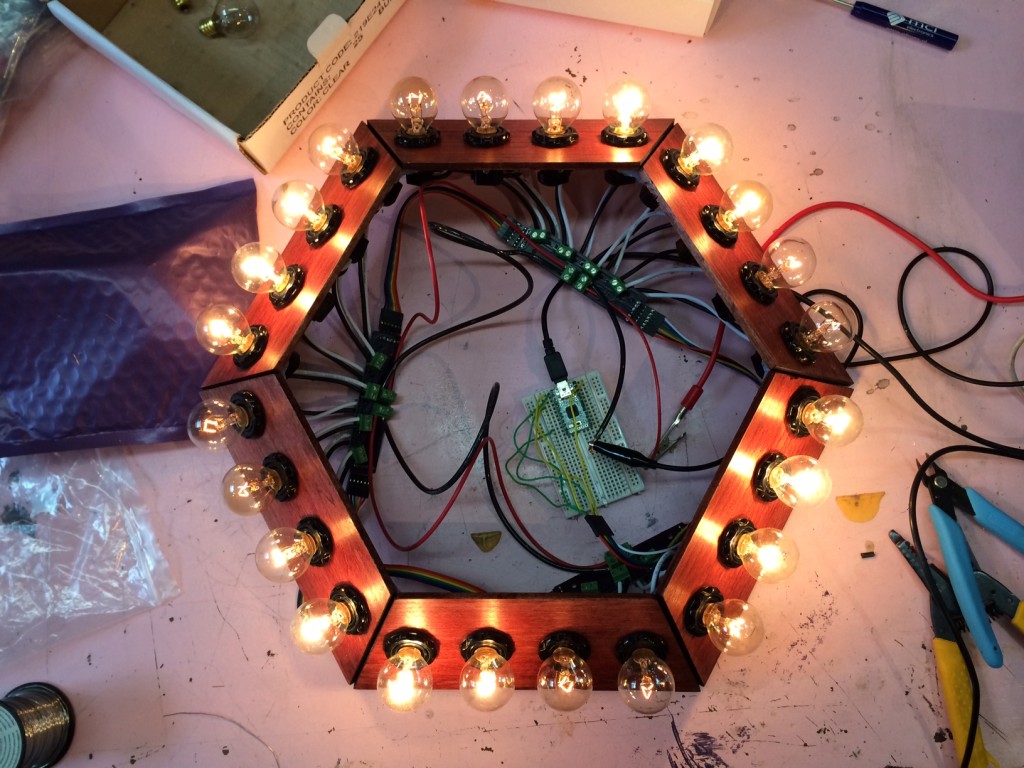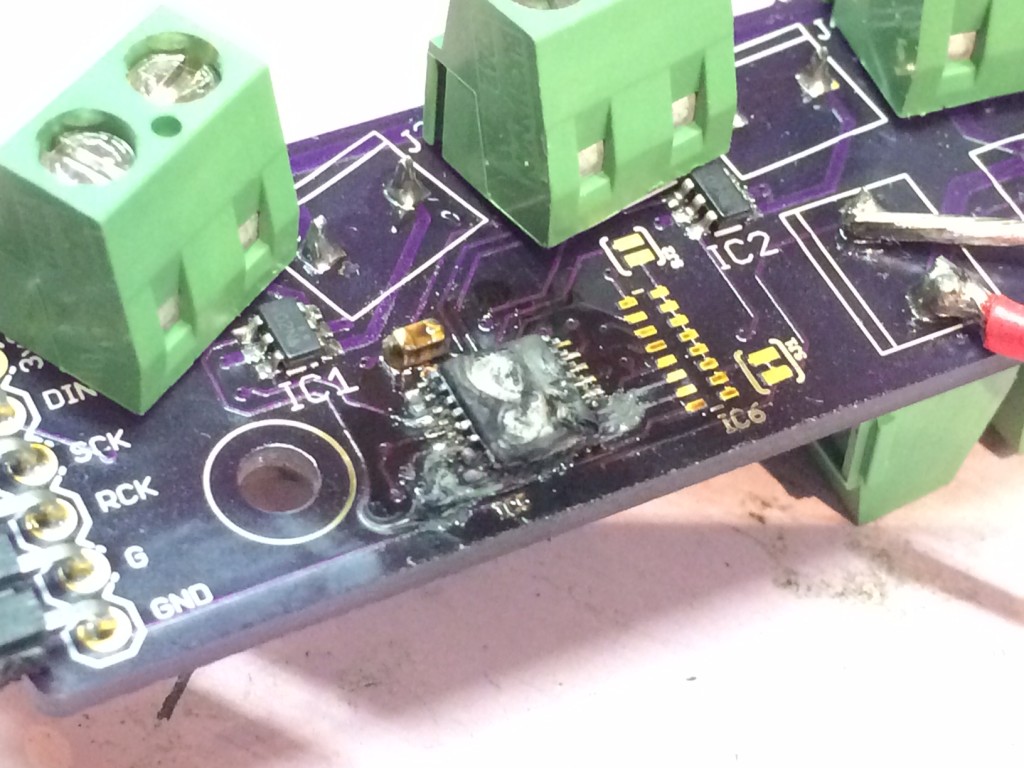Is something metal burning?
On Friday night I experienced what is probably my most spectacular hardware failure yet. I was working on a project for our upcoming Interactive Show, a chandelier with 150 or so individually controllable 5 watt incandescent bulbs:

A small piece of the chandelier during testing.
Anyway, it was way too late and I was rushing to get the last controller board finished on the outer ring of the chandelier, which has 7 controllers and 52 lightbulbs. I plugged the very last controller in backwards and flipped the switch…
Fwoosh. The final controller went up in smoke. Because of the way the boards are set up, 24 volts from a beefy power supply shot backwards into the chip’s power rails. Of course, to get there, the voltage had to flow all the way around the ring, blowing a chunk out of every chip in line, killing the Teensy microcontroller I was using, then feeding into my USB port and frying my laptop, which started smoking as well. It was pretty spectacular – probably the most amount of money and effort I’ve burned in under a second.
Takeaways:
1) Don’t work tired. Nothing of quality ever comes from staying up late. Or rushing. Haste makes waste, as they say.
2) Think about how your power flows. More importantly, think about how your power might flow in different situations. If it’s possible for the power to be hooked up backwards, consider protection diodes, or isolating your power rails, or using a keyed connector.
3) Be thoughtful about your connectors. It’s easy and tempting to design simple things with 0.1″ headers, but this way lies danger. If your project can be damaged by reversing the connector, redesign the pinout, or use a keyed connector that can only be used in one orientation. This makes sure that your tired brain can’t do any serious damage.
4) Isolate your USB devices. A USB isolator might not be a bad investment if you work on a lot of USB devices, especially ones that also use higher voltages. They’re not terribly expensive, but unfortunately are not capable of handling High Speed (480 Mbps), although Full Speed (12 Mbps) is fine. But you can definitely isolate the power rails, which would have at least saved my laptop here.
5) If you find yourself in a similar what-the-heck-just-happened situation (if you don’t, you’re not pushing hard enough), use it as a learning opportunity. Stop and reflect on what happened and how you can improve next time. Ask questions! Just the act of explaining something to another person helps you understand it better. Then blog about it and press on.
Any other interesting #fails / learning experiences? Post ’em in the comments!

Ouch.. burning stuff can always happen, but to burn your laptop sucks. 🙁
And yes you are right, if you can connect it the wrong way, it may very well happen some day. I like to mark connectors clearly to show which way they connect, and what they are. I’ve found that using only black and white tape is a great way to still be able to read your markings even in the dark or when color blind. Also, even if you think this is just a quick and dirty project, it is probably worth the effort in the end. Projects live longer than you think, and by that time you won’t remember how to connect everything by heart.
“A USB isolator might not be a bad investment if you work on a lot of USB
devices, especially ones that also use higher voltages.”
Awesome timing. I’m from VHS in Vancouver Canada, we did an SMD build recently of USB isolators. I have an offer from Farnell of 13 free ADUM3160, I can offer you 13 PCBs at cost (1.30 each). Do you guys have someone who could run an SMD workshop using these materials? tom dot m dot keddie at gmail.
http://vancouver.hackspace.ca/wp/2014/03/15/smd-april-usb-isolator/
If you check ebay you can find ones that have a jumper for full and highspeed. I got one for under 30 with an onboard isolated dc supply. http://www.ebay.com/itm/Full-speed-USB-Isolator-Built-in-DC-DC-2watt-converter-350mA-EtimesParts-/251568771811?pt=LH_DefaultDomain_0&hash=item3a92aad2e3
After a few mishaps of my own, I gave up on power connector polarity. Now, all my power ports are run through a bridge rectifier. Forwards, backwards, AC, DC, does not matter… it comes out DC in the right polarity on the other side of the bridge. Of course, it helps that I have a huge stack of bridge rectifiers from an estate sale…
If I had a dollar for every time I’ve said (or heard) do you smell metal burning… I’d be a very rich man. Between electronics repair shops, hobbyist electronics, servers & routers, data centers and more.